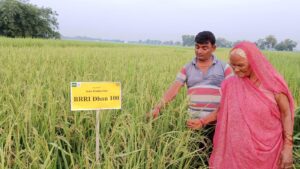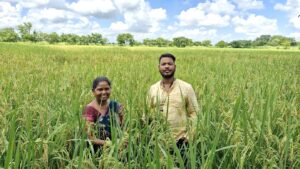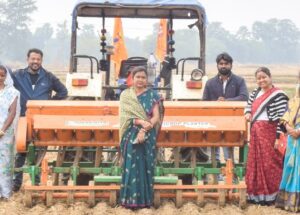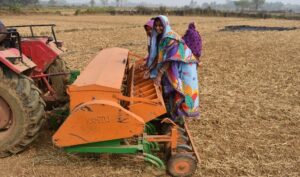Finding meaningful work in the developing world with rice
I ended up at IRRI in a quite roundabout way. I actually came into science late in my career. I had lived and traveled extensively in Latin America before coming back to the United States for graduate school. I had realized that my background in literature and history wasn’t going to give me the tools that I needed to find meaningful work in the developing world, which was one of the aspirations I had.
So, I returned to the United States with interests in agriculture, nutrition, food supply, and health (but not necessarily medicine). That range of interests converged on the field of agriculture and specifically on rice as a staple food. Access to food was the understory for a lot of the nutritional problems and nutrient deficiencies that I had seen during my travels.
At the time I entered graduate school, I didn’t know that I would be able to study something so well-suited to my interests. I entered the PhD program in plant breeding and genetics at Cornell University as an older person, after my first child was born. I had deferred to my husband’s career preparation first. By that time, we were thinking very hard about how we could “architect” a life that would give us both professional opportunities in the developing world.
Being female with a young baby forces probation
While my husband, Paul Coen, was in veterinary school, I was a staff technician at Cornell. During that time, I took a very well-known international agriculture course. Through conversations with many participants during that course, I concluded that I wanted to do graduate work in plant breeding. It had not occurred to me before but it fit very well with many of the interests I had, and with my MS preparation in plant pathology.
In 1985, when I applied to the field of plant breeding at Cornell, it was the first time that a female with a young baby was accepted to become a graduate student. Several of the professors felt it was too great a handicap, and that I would never work in the field. I think they felt that, maybe, I was going to attend classes, get an education, but never work professionally.
So, I was accepted on probation and I had to prove myself. Despite the fact that many of the male students in the department had young babies at home, this was not grounds for questioning their professional aspirations. But, anyway, I entered the department and I worked very diligently and I think I demonstrated a serious commitment.
My timing was really fortunate because the Rockefeller Foundation’s Program on Rice Biotechnology had just started in 1985. Ray Wu [the late Cornell professor of molecular biology and genetics, who was widely recognized as one of the fathers of plant genetic engineering], Ronnie Coffman [IRRI plant breeder, 1971- 81 and currently director of Cornell’s International Programs], and Cornell plant breeder Steve Tanksley had put forward a proposal to do some molecular biology on rice that would involve developing, in those days, an RFLP [restriction fragment length polymorphism] map.
So, as I entered the department and considered the various opportunities that presented themselves as PhD projects, this was the one that stood out in my mind. Initially, I was told that I didn’t have the qualifications to take on that project. But I slowly worked my way into it and, after the first year, was selected for a fellowship under that program. So, my PhD program was largely funded by the Rockefeller Foundation.
Great teamwork—developing the first molecular map of rice
I became a full-fledged graduate student in 1986. During that time, I worked very closely with two Chinese colleagues [Z.H. Yu and Z.Y. Wang] who were also Rockefeller-funded scholars. Our threesome—the two scholars and I—put together that first RFLP map of rice, which was published in 1988 [Theoretical and Applied Genetics: Molecular mapping of rice chromosomes, 76:815-829].
It was a great achievement derived from teamwork. We learned a lot from Steve Tanksley, a tomato geneticist, who was making his first foray into cereals, specifically rice. The RFLP technology, as those who worked with it know, is cumbersome and very tedious. It involved a lot of work using radiation and almost a 24-hour routine in the lab. We worked day and night to develop this map, and it was a great accomplishment in its day—135 markers across rice’s 12 chromosomes.
Anyway, it was the first molecular map of rice, very historic, and we were very excited. I made my first trip to IRRI to present the results of that work in 1988. I remember being stunned by the number of researchers at IRRI in so many diverse fields, all of them concentrated on rice. I was excited by it all. I think people were equally excited by the work we were doing at Cornell. There was a very good synergy and I think that first visit cemented a relationship that would evolve into a job opportunity at IRRI when I finished my PhD.
The IRRI experience
In 1990, when I received my PhD from Cornell, I had just given birth to my second child, Andre. When he was about 8 weeks old, the family moved to the Philippines so that I could take up a position as an internationally recruited geneticist at IRRI. My first task was to set up a molecular breeding lab—a historic first.
We were on the cutting edge of the technology based on what we had developed at Cornell, and we were going to try to implement it at IRRI, putting the molecular markers into action in the context of plant breeding—and in the context of rice improvement for the developing world. For me, it fulfilled my dream of combining science—and the excitement of the new kind of science that was just emerging at the time—with the frontier of developing new varieties of rice. We aimed to encourage better use of the natural resources that were available to people.
Of course, the other underlying theme was: could we use genetics to minimize the amount of pesticide use and improve fertilizer efficiency? Today, we’re very interested in water-use efficiency as well.
Creating excitement overcomes resistance
All of this came together in this wonderful career opportunity. I think that my family really appreciated what it meant to me, after 4 years in the PhD program, to have the chance to go to IRRI and try to integrate the new genetic tools into the breeding process there—it was something that required as much interpersonal and political will as scientific expertise.
During the early days, there was a fair amount of resistance to spending time and money on using molecular markers to do something that the breeders thought they already did very well. There was a time when the new technology was both embraced and resisted, and a little bit resented. I was right at that edge.
So, I did my best to try to introduce the technology in ways that would allow others to share the excitement of what I believed was possible when these markers were used to identify genes controlling the traits that breeders selected for. And so, for the last 20 years, that is what I have spent my life doing. We’ve continued to use a participatory approach. I’ve tried to bring people from diverse backgrounds into the process and share the excitement of what science has meant to me.
At the same time, I’ve tried to learn from others where the most pressing problems lie and to address those problems using germplasm and natural variation that is of most interest to them. This has always been a combined effort to show others what was possible and to use genetics wisely for plant improvement.
Greatest achievement: Genome Mapping Laboratory
I think my greatest achievement at IRRI was developing that first marker lab—I think it’s still called the Genome Mapping Laboratory [now referred to as the Molecular Breeding Laboratory]. This program has been modified and enlarged and now occupies a central place in the breeding program.
Just thinking back to what it meant to pioneer such a program, I remember the very first look I had at what the space would be—there were no windows; it was just a brick building with a garage underneath. I said: “I think the first thing we need to do is to put in windows so we can look out on the rice paddies and the beautiful volcanic mountains in the background.”
Indeed, we insisted on that. I still walk into that laboratory and remember the decision to put in the windows that was part of designing the facility. To see it functioning and working today and booting out good science and good products is probably the greatest reward.
Greatest frustration: no work for the spouse
The hardest thing for me was that my spouse was unable to acquire a work visa. In 1990, spouses could not get work visas. [Even today in the Philippines, a work permit for a spouse is not automatically given upon application and depends on what kind of work the permit is being requested for.] Paul had a veterinary practice in New York and he had expected to be able to work in the Philippines. He was paying back his student loans and foregoing a normal salary line. He had a skill set that would have been useful.
I think the greatest frustration was that he couldn’t work and he found it very difficult to develop meaningful professional relationships. That is why the family moved into a “shuttle” research relationship during the last 3 years of my 5-year contract, that is, I traveled back and forth between New York and the Philippines.
Mistaken identity: all Caucasian women look alike
There were just two female internationally recruited staff members at that time at IRRI. It was rare to be female in the scientific arena and my colleague Rebecca Nelson [IRRI molecular plant pathologist, 1989-96] and I were the two females. Other than the fact that we both are Caucasians, we really didn’t look alike. She has dark brown eyes; I have blue eyes; she has very curly hair; I have very long straight hair, and during one year she was pregnant.
So, about the time she was 9 months pregnant, walking around with a big belly and her curly hair and brown eyes, and me with my long, straight hair, and no belly, I can remember that many people would see me passing and say, “Hi, Rebecca,” and they’d see her passing and say, “Hi, Susan,” because, I think, to them, we looked very much the same. We laugh about that even today.
People still ask me, when I visit IRRI, how is my husband, Johnny? Of course, Johnny is Rebecca’s husband and Paul is mine— they still confuse us! That is something we always found very humorous.
National staff make IRRI tick
I think the national staff is what really makes IRRI tick. When I first went to IRRI, my learning curve about Asia, about rice, and about many of the things that I now do professionally started with the knowledge that was transmitted to me by the national staff.
Cultivating a loyal “extended” family
I was at IRRI for a relatively short time—really just under 2 years with my family, although I’ve spent many weeks and months there since that time. I think it was really the foundation of my career. It allowed me to join that “extended” family that IRRI has created over its 50 years and to be a participant both from within and from without.
A great joy has been the interaction with the Filipino staff and the people whom I trained and the many international scholars who came to my lab or whom I’ve known through my collaborations over the many years. Training people enables one to keep extending the sense of family. People go back to their countries where they continue to work and interact in the international arena.
Having participated in an emerging program when molecular breeding technology was just coming on-line really solidified a kind of family bonding that we still enjoy today. Overall, I believe that this extended family is very loyal to the vision and to the ideal that IRRI represents. So, even if I feel that we need to reinvent ourselves and to reinvent many of our international organizations, I think we all keep somewhere deep within us the vision of what the organization represents, even as it evolves and becomes something new.
Go to www.irri.org/publications/today/McCouch.asp for the full transcript and video clips of Dr. McCouch’s interview, in which she also reflects on the challenges of being a female in scientific research; the creation of IRRI’s new training course, Rice: research to production; IRRI challenges in 2010 and beyond; and what the future holds, in her view, for packaging better rice varieties









